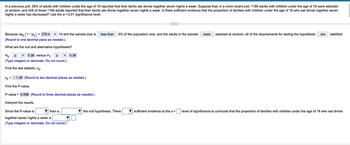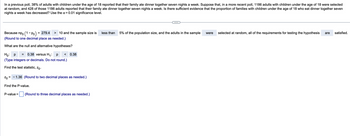In a previous poll, 38% of adults with children under the age of 18 reported that their family ate dinner together seven nights a week. Suppose that, in a more recent poll, 1186 adults with children under the age of 18 were selected at random, and 428 of those 1186 adults reported that their family ate dinner together seven nights a week. Is there sufficient evidence that the proportion of families with children under the age of 18 who eat dinner together seven nights a week has decreased? Use the a= 0.01 significance level. Because npo (1-Po)=L 10 and the sample size is (Round to one decimal place as needed.) 5% of the population size, and the adults in the sample selected at random, all of the requirements for testing the hypothesis satisfied.
In a previous poll, 38% of adults with children under the age of 18 reported that their family ate dinner together seven nights a week. Suppose that, in a more recent poll, 1186 adults with children under the age of 18 were selected at random, and 428 of those 1186 adults reported that their family ate dinner together seven nights a week. Is there sufficient evidence that the proportion of families with children under the age of 18 who eat dinner together seven nights a week has decreased? Use the a= 0.01 significance level. Because npo (1-Po)=L 10 and the sample size is (Round to one decimal place as needed.) 5% of the population size, and the adults in the sample selected at random, all of the requirements for testing the hypothesis satisfied.
MATLAB: An Introduction with Applications
6th Edition
ISBN:9781119256830
Author:Amos Gilat
Publisher:Amos Gilat
Chapter1: Starting With Matlab
Section: Chapter Questions
Problem 1P
Related questions
Question
![**Text:**
In a previous poll, 38% of adults with children under the age of 18 reported that their family ate dinner together seven nights a week. Suppose that, in a more recent poll, 1186 adults with children under the age of 18 were selected at random, and 428 of those 1186 adults reported that their family ate dinner together seven nights a week. Is there sufficient evidence that the proportion of families with children under the age of 18 who eat dinner together seven nights a week has decreased? Use the α = 0.01 significance level.
---
Because np₀(1 - p₀) = [textbox] ≥ 10 and the sample size is [dropdown] 5% of the population size, and the adults in the sample [dropdown] selected at random, all of the requirements for testing the hypothesis [dropdown] satisfied.
(Round to one decimal place as needed.)
---
**Explanation:**
There are no additional graphs or diagrams in this image. The content is presented in the form of a hypothesis test problem statement, with interactive elements like textboxes and dropdown menus for input.](/v2/_next/image?url=https%3A%2F%2Fcontent.bartleby.com%2Fqna-images%2Fquestion%2Fac3be618-b645-4bd8-855b-808ff3fc18d4%2F1bf6b922-5cc8-4c6c-a616-ce1863938327%2F5yuyet_processed.png&w=3840&q=75)
Transcribed Image Text:**Text:**
In a previous poll, 38% of adults with children under the age of 18 reported that their family ate dinner together seven nights a week. Suppose that, in a more recent poll, 1186 adults with children under the age of 18 were selected at random, and 428 of those 1186 adults reported that their family ate dinner together seven nights a week. Is there sufficient evidence that the proportion of families with children under the age of 18 who eat dinner together seven nights a week has decreased? Use the α = 0.01 significance level.
---
Because np₀(1 - p₀) = [textbox] ≥ 10 and the sample size is [dropdown] 5% of the population size, and the adults in the sample [dropdown] selected at random, all of the requirements for testing the hypothesis [dropdown] satisfied.
(Round to one decimal place as needed.)
---
**Explanation:**
There are no additional graphs or diagrams in this image. The content is presented in the form of a hypothesis test problem statement, with interactive elements like textboxes and dropdown menus for input.
Expert Solution
This question has been solved!
Explore an expertly crafted, step-by-step solution for a thorough understanding of key concepts.
This is a popular solution!
Trending now
This is a popular solution!
Step by step
Solved in 3 steps with 5 images

Follow-up Questions
Read through expert solutions to related follow-up questions below.
Follow-up Question

Transcribed Image Text:In a previous poll, 38% of adults with children under the age of 18 reported that their family ate dinner together seven nights a week. Suppose that, in a more recent poll, 1186 adults with children under the age of 18 were selected
at random, and 428 of those 1186 adults reported that their family ate dinner together seven nights a week. Is there sufficient evidence that the proportion of families with children under the age of 18 who eat dinner together seven
nights a week has decreased? Use the α = 0.01 significance level.
Because npo (1-Po) = 279.4 > 10 and the sample size is
(Round to one decimal place as needed.)
What are the null and alternative hypotheses?
Ho: P = 0.38 versus H₁: р
(Type integers or decimals. Do not round.)
Find the test statistic, Zo.
< 0.38
Zo = - 1.36 (Round to two decimal places as needed.)
Find the P-value.
P-value = 0.088 (Round to three decimal places as needed.)
Interpret the results.
Since the P-value is
than α,
together seven nights a week is
(Type integers or decimals. Do not round.)
less than 5% of the population size, and the adults in the sample were selected at random, all of the requirements for testing the hypothesis are satisfied.
the null hypothesis. There
sufficient evidence at the α =
level of significance to conclude that the proportion of families with children under the age of 18 who eat dinner
Solution
Follow-up Question

Transcribed Image Text:In a previous poll, 38% of adults with children under the age of 18 reported that their family ate dinner together seven nights a week. Suppose that, in a more recent poll, 1186 adults with children under the age of 18 were selected
at random, and 428 of those 1186 adults reported that their family ate dinner together seven nights a week. Is there sufficient evidence that the proportion of families with children under the age of 18 who eat dinner together seven
nights a week has decreased? Use the α = 0.01 significance level.
Because npo (1-Po) = 279.4 > 10 and the sample size is
(Round to one decimal place as needed.)
What are the null and alternative hypotheses?
но: р
= 0.38 versus H₁: p
(Type integers or decimals. Do not round.)
Find the test statistic, Zo.
< 0.38
Zo -1.36 (Round to two decimal places as needed.)
=
Find the P-value.
P-value = (Round to three decimal places as needed.)
less than 5% of the population size, and the adults in the sample
were
selected at random, all of the requirements for testing the hypothesis are satisfied.
Solution
Follow-up Question

Transcribed Image Text:**Hypothesis Testing: Proportion of Families Eating Dinner Together**
In a previous poll, 38% of adults with children under the age of 18 reported that their family ate dinner together seven nights a week. Suppose that, in a more recent poll, 1186 adults with children under the age of 18 were selected at random, and 428 of those 1186 adults reported that their family ate dinner together seven nights a week. Is there sufficient evidence that the proportion of families with children under the age of 18 who eat dinner together seven nights a week has decreased? Use the α = 0.01 significance level.
**Conditions for Hypothesis Testing:**
- The expression \( np_0 (1 - p_0) = 279.4 \) satisfies the condition \( > 10 \).
- The sample size is less than 5% of the population size.
- The adults in the sample were selected at random.
All requirements for testing the hypothesis are satisfied.
**Hypotheses:**
- Null Hypothesis (\( H_0 \)): \( p = 0.38 \)
- Alternative Hypothesis (\( H_1 \)): \( p < 0.38 \)
**Test Statistic:**
- Calculate the test statistic \( z_0 \).
- The formula to find \( z_0 \) should be used to round to two decimal places as needed.
This step-by-step setup guides you through understanding if there is a significant decrease in the proportion of families having dinner together seven nights a week.
Solution
Follow-up Question

Transcribed Image Text:**Title: Hypothesis Testing in Family Dining Habits**
**Introduction:**
In a previous poll, 38% of adults with children under the age of 18 reported that their family ate dinner together seven nights a week. In a more recent poll, 1,186 adults with children under the age of 18 were selected at random, and 428 of those adults reported that their family ate dinner together seven nights a week. We aim to assess whether there is sufficient evidence that the proportion of families with children under the age of 18 who eat dinner together seven nights a week has decreased. We will use a significance level of α = 0.01.
**Calculation and Assumptions:**
- Sample Size: 1,186 adults
- Reported Family Dinners: 428
- Significance Level: α = 0.01
**Assumptions for Hypothesis Testing:**
- Calculation of np₀(1 - p₀) = 279.4, which is greater than 10.
- The sample size is less than 5% of the population size.
- The adults in the sample were selected at random.
All these criteria ensure the validity of the hypothesis test.
**Hypotheses:**
- Null Hypothesis (H₀):
- Alternative Hypothesis (H₁):
*(Please enter integers or decimals for null and alternative hypotheses without rounding.)*
**Conclusion:**
The setup of this hypothesis test helps determine if there has been a significant change in family dining habits over time. Filling the hypotheses correctly will lead to determining if there is statistically significant evidence of a decrease in families dining together every night.
Solution
Recommended textbooks for you

MATLAB: An Introduction with Applications
Statistics
ISBN:
9781119256830
Author:
Amos Gilat
Publisher:
John Wiley & Sons Inc

Probability and Statistics for Engineering and th…
Statistics
ISBN:
9781305251809
Author:
Jay L. Devore
Publisher:
Cengage Learning

Statistics for The Behavioral Sciences (MindTap C…
Statistics
ISBN:
9781305504912
Author:
Frederick J Gravetter, Larry B. Wallnau
Publisher:
Cengage Learning

MATLAB: An Introduction with Applications
Statistics
ISBN:
9781119256830
Author:
Amos Gilat
Publisher:
John Wiley & Sons Inc

Probability and Statistics for Engineering and th…
Statistics
ISBN:
9781305251809
Author:
Jay L. Devore
Publisher:
Cengage Learning

Statistics for The Behavioral Sciences (MindTap C…
Statistics
ISBN:
9781305504912
Author:
Frederick J Gravetter, Larry B. Wallnau
Publisher:
Cengage Learning

Elementary Statistics: Picturing the World (7th E…
Statistics
ISBN:
9780134683416
Author:
Ron Larson, Betsy Farber
Publisher:
PEARSON

The Basic Practice of Statistics
Statistics
ISBN:
9781319042578
Author:
David S. Moore, William I. Notz, Michael A. Fligner
Publisher:
W. H. Freeman

Introduction to the Practice of Statistics
Statistics
ISBN:
9781319013387
Author:
David S. Moore, George P. McCabe, Bruce A. Craig
Publisher:
W. H. Freeman